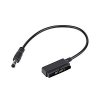D
Deleted member 94047
Guest
Hello all,
I know this has been asked before in one form or another but I guess it needs to be asked once more; so here goes. I have a 84.4Wh portable power bank I use for powering a small telescope. It can output a consistent 12V DC @3000mA. And I can get the below charging cable from amazon for cheap to plug the MA battery in to said power bank directly. My question is:
(1) Will this even work - considering the original MA battery charger outputs 13.2V @ 3.79 A
(2) If it does work - how many batteries can I possibly charge with this? My simple math would tell me about 3 but I don't trust my math skills.
(3) And this is the part I am worried about - does this have the potential to damage either of the batteries involved?
I should add that I already have three batteries for the MA and that certainly helps. But if this setup can give me juice for charging them on the go I will be one happy flyer. Any insights will be greatly appreciated. And thank you for making this place so resourceful, this forum is like a flight school.
I know this has been asked before in one form or another but I guess it needs to be asked once more; so here goes. I have a 84.4Wh portable power bank I use for powering a small telescope. It can output a consistent 12V DC @3000mA. And I can get the below charging cable from amazon for cheap to plug the MA battery in to said power bank directly. My question is:
(1) Will this even work - considering the original MA battery charger outputs 13.2V @ 3.79 A
(2) If it does work - how many batteries can I possibly charge with this? My simple math would tell me about 3 but I don't trust my math skills.
(3) And this is the part I am worried about - does this have the potential to damage either of the batteries involved?
I should add that I already have three batteries for the MA and that certainly helps. But if this setup can give me juice for charging them on the go I will be one happy flyer. Any insights will be greatly appreciated. And thank you for making this place so resourceful, this forum is like a flight school.











